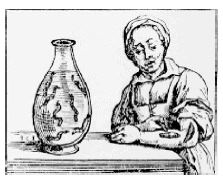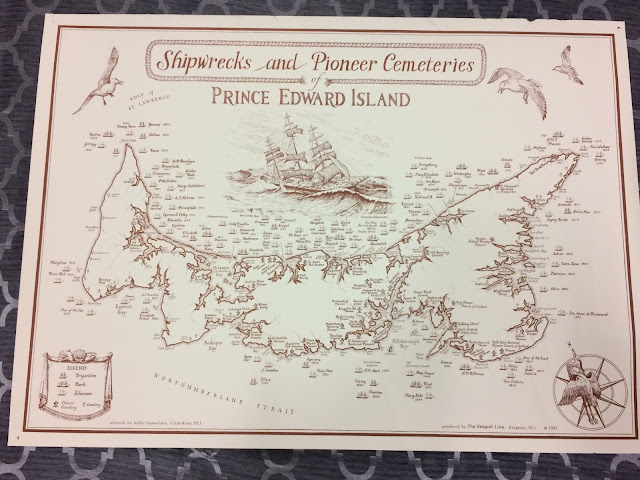Leeches: An Early Staple for PEI Doctors
In the nineteenth century, medicine was not something many Islanders could afford. In 1859, The Islander newspaper stated that "the dread of a doctors bill kept poorer classes from getting help from doctors."
Most Islanders used home remedies or relied on the remedies of their friends and families for their health. Seeing a doctor was expensive and many did not have the money to pay the bill. Instead, doctor bills were paid in goods and services, usually farm produce, potatoes, fish, leather, wheat, and other goods. Assuming you had enough to pay the bill this way.
So let's say you have an issue that requires a doctor -
Well, first you need to find a doctor who is actually qualified. In 1859, the PEI Medical Association tried to get the government to regulate the industry because there were so many quacks. These quacks, or quacksalvers, had questionable degrees and made and peddled medicines - often made from alcohol and opium. Think snake oil salesmen.
So let's say you have gone to a qualified doctor. What will this doctor do for you?
Surgery: with no anesthetic, sterilization, and little knowledge of bacteria, surgery was often fatal. When surgery was done, it was usually for setting broken bones, lancing boils, hernias, and amputations. While many survived the initial surgery, infection led many to the grave.
Drugs: Some of these drugs were natural and safe (if they even worked). But, others included opium to calm the patient; quinine, arsenic, and strychnine were used to quicken a weakened heartbeat; mercury for constipation and dry-mouth; laudanum to lower your temperature; leeching for fevers, slow a rapid heartbeat, and to remove bad spirits; liquor would raise low spirits and quicken your heart rate; and laxatives and emetics to cleanse the bowels and stomach. Once treatment was administered, the doctors prescribed their tonics and stimulants to the patients.
Now we know not to use many of these treatments...if a doctor tells you they are going to treat your high heart rate with arsenic or your dry-mouth with mercury - run. Just run. And report them...
Doctors had to rely on external signs of illness that they could see as they did not have the diagnostic tools we do today. These visible signs could be unusual sweating, discolouration of urine, and marks on the skin.
In these days, doctors often used leeching. In fact, you can still get leech therapy in some places. Doctors believed the leeches would remove poisoned or infected blood. Doctors would clean the area and apply the leech.
If the leech wasn't in the mood to feed, doctors would sometimes prick their own fingers and place a drop of blood onto the patient, enticing the leech to feed. The leech would keep feeding until they were full. Then they let go of the body. The average leech only consumed about one teaspoon of blood before it was full. Therefore, the doctor had to either use more than one leech or use other means to bleed the patient of "bad blood."
Sometimes the doctor would place a glass over the leech to keep it in one area. Take it from someone who had the opportunity to hold a leech (me), they wiggle a lot. So when they let go of the patient, they would sometimes roll off the body. Sometimes they would roll into other parts of the body. Therefore, sometimes doctors would have to give patients medicine to induce vomiting or bowel movements - remember, these were not always giant leeches the size of your hand, they were smaller and sometimes could get lost.
Leeching is not very popular now and when it is used, it's not for "bad blood." Leeches secrete anticoagulants when they feed. This keeps the wound from closing. I spoke with someone who worked with leeches and come feeding time, he often used his own arm. Now, if the leech isn't attached for very long, the wound doesn't take long to heal - leeches do not exactly have big mouths. But, if it's feeding for too long, it can take a while for the wound to heal. He told us that one time, he fed one of the leeches in the afternoon (and these where big leeches, about the length of your hand) and the wound didn't finally seal until sometime that night when he was sleeping. Again, it is a small wound so it wasn't dangerous, more annoying than anything.
Some of you may see where this is going, some places will use leeches on patients who are prone to blood clots or bad circulation. This is especially true when appendages are re-connected to the body. Doctors can suture arteries or large veins but not the smaller ones.
If a leech is attached near the re-attached appendage, such as a finger or toe, the leech will feed, secrete the anticoagulant, and when it's finished feeding (about a half hour later), the wound will stop bleeding in about 10 hours. At which time, doctors may decide to attach another one. Because the wound isn't closing, blood is continuously moving to the area which will help restore the veins.
If you want more info on that, click here to go to an article by Health Line and click here for the Britannica article. Of course, like any medicine, you will still find people out there trying to turn it into a miracle cure or use it for a condition that it will do nothing for.
Using leeches started to decline around 1850. Mainly due to the mechanical leech. A device that allowed your doctor to bleed you without using a live leech. Essentially, the equipment changed, not the theories behind the treatment.
Baldwin, D. Prince Edward Island: An Illustrated History. Halifax: Nimbus Publishing, 2009.
"1850s Prince Edward Island." Culture Summerside. http://culturesummerside.com/assets/Program-1850s-Prince-Edward-Island.pdf
 |
| (Image Credit) |
Most Islanders used home remedies or relied on the remedies of their friends and families for their health. Seeing a doctor was expensive and many did not have the money to pay the bill. Instead, doctor bills were paid in goods and services, usually farm produce, potatoes, fish, leather, wheat, and other goods. Assuming you had enough to pay the bill this way.
So let's say you have an issue that requires a doctor -
Well, first you need to find a doctor who is actually qualified. In 1859, the PEI Medical Association tried to get the government to regulate the industry because there were so many quacks. These quacks, or quacksalvers, had questionable degrees and made and peddled medicines - often made from alcohol and opium. Think snake oil salesmen.
So let's say you have gone to a qualified doctor. What will this doctor do for you?
Surgery: with no anesthetic, sterilization, and little knowledge of bacteria, surgery was often fatal. When surgery was done, it was usually for setting broken bones, lancing boils, hernias, and amputations. While many survived the initial surgery, infection led many to the grave.
Drugs: Some of these drugs were natural and safe (if they even worked). But, others included opium to calm the patient; quinine, arsenic, and strychnine were used to quicken a weakened heartbeat; mercury for constipation and dry-mouth; laudanum to lower your temperature; leeching for fevers, slow a rapid heartbeat, and to remove bad spirits; liquor would raise low spirits and quicken your heart rate; and laxatives and emetics to cleanse the bowels and stomach. Once treatment was administered, the doctors prescribed their tonics and stimulants to the patients.
Now we know not to use many of these treatments...if a doctor tells you they are going to treat your high heart rate with arsenic or your dry-mouth with mercury - run. Just run. And report them...
 |
| If anyone tries to give this to you...run! (Image credit) |
Doctors had to rely on external signs of illness that they could see as they did not have the diagnostic tools we do today. These visible signs could be unusual sweating, discolouration of urine, and marks on the skin.
In these days, doctors often used leeching. In fact, you can still get leech therapy in some places. Doctors believed the leeches would remove poisoned or infected blood. Doctors would clean the area and apply the leech.
If the leech wasn't in the mood to feed, doctors would sometimes prick their own fingers and place a drop of blood onto the patient, enticing the leech to feed. The leech would keep feeding until they were full. Then they let go of the body. The average leech only consumed about one teaspoon of blood before it was full. Therefore, the doctor had to either use more than one leech or use other means to bleed the patient of "bad blood."
Sometimes the doctor would place a glass over the leech to keep it in one area. Take it from someone who had the opportunity to hold a leech (me), they wiggle a lot. So when they let go of the patient, they would sometimes roll off the body. Sometimes they would roll into other parts of the body. Therefore, sometimes doctors would have to give patients medicine to induce vomiting or bowel movements - remember, these were not always giant leeches the size of your hand, they were smaller and sometimes could get lost.
Leeching is not very popular now and when it is used, it's not for "bad blood." Leeches secrete anticoagulants when they feed. This keeps the wound from closing. I spoke with someone who worked with leeches and come feeding time, he often used his own arm. Now, if the leech isn't attached for very long, the wound doesn't take long to heal - leeches do not exactly have big mouths. But, if it's feeding for too long, it can take a while for the wound to heal. He told us that one time, he fed one of the leeches in the afternoon (and these where big leeches, about the length of your hand) and the wound didn't finally seal until sometime that night when he was sleeping. Again, it is a small wound so it wasn't dangerous, more annoying than anything.
Some of you may see where this is going, some places will use leeches on patients who are prone to blood clots or bad circulation. This is especially true when appendages are re-connected to the body. Doctors can suture arteries or large veins but not the smaller ones.
 |
| Gross, but will help with circulation (Image Credit) |
If a leech is attached near the re-attached appendage, such as a finger or toe, the leech will feed, secrete the anticoagulant, and when it's finished feeding (about a half hour later), the wound will stop bleeding in about 10 hours. At which time, doctors may decide to attach another one. Because the wound isn't closing, blood is continuously moving to the area which will help restore the veins.
If you want more info on that, click here to go to an article by Health Line and click here for the Britannica article. Of course, like any medicine, you will still find people out there trying to turn it into a miracle cure or use it for a condition that it will do nothing for.
 |
| Mechanical Leech (Image Credit) |
Using leeches started to decline around 1850. Mainly due to the mechanical leech. A device that allowed your doctor to bleed you without using a live leech. Essentially, the equipment changed, not the theories behind the treatment.
Baldwin, D. Prince Edward Island: An Illustrated History. Halifax: Nimbus Publishing, 2009.
"1850s Prince Edward Island." Culture Summerside. http://culturesummerside.com/assets/Program-1850s-Prince-Edward-Island.pdf


Comments
Post a Comment